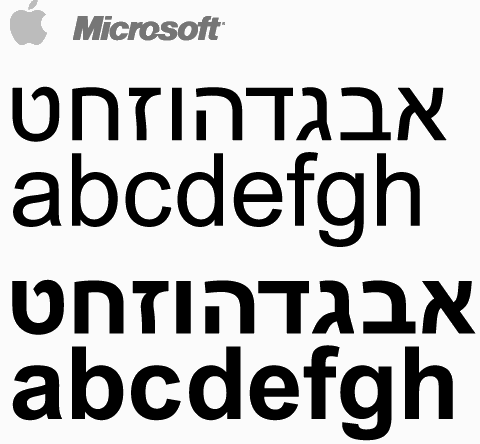Arial Hebrew Fonts

DNSRBL available at with lookups to rbl.interserver.net Stats Info on 88.99.2.89 Abuse DB ID 722236 First Seen 2017-12-26 03:16:16 Last Seen 2019-03-08 01:10:41 Reason 'mod_security' Total Servers 44 Total listings 121 Error: Your IP may be getting blocked by our IPS due to a known string of false positive. Download nfs mw 2012 fixer.
Symptom Some users have found that certain fonts they use are missing after upgrading to Windows 10. For example, if the English (or German, Spanish.) version of Windows 10 was installed, then the Gautami, Meiryo, Narkism. Font is missing. Cause Many fonts that shipped in prior versions of Windows have been moved into optional features in Windows 10. After upgrading to Windows 10, these optional features may not be installed on your system.
Hebrew is used in the writing of the Jewish languages, including Hebrew, Yiddish, Ladino, and Judeo-Arabic. The Hebrew alphabet consists of 22 consonants. There is no differentiation between uppercase and lowercase letters. Hebrew is written and read from right to left. Open-source Unicode Hebrew Fonts (sorted by diacritic support and style) • פונטים בעברית, יוניקוד וקוד פתוח. Click on a font name below for a download link, and to review a summary of the font’s diacritic positioning and character support. See bottom of page for a font comparison chart ( PDF ).
The result is that the fonts in those optional features will not be present. If you need to use a font in one of these optional features, any of them can be installed on any Windows 10 system, as explained below. Background Since Windows Vista, every Windows system has included all Windows fonts. Windows supports many languages, and many of the fonts are intended primarily for use with particular languages.
For example, the Meiryo or Raavi font can be used for English, but they were added to Windows to support other languges: Meiryo was created to support Japanese; Raavi was created to support Panjabi or other languages written in Gurmukhi script. Most English (or German, Arabic, Ukrainian.) speakers don't use Gurmukhi or Japanese writing, but they still would all have these fonts on their system, and many others intended for particular languages. Having fonts that aren't needed or being used provides no benefit, but they take up system resources and clutter up font lists with options that have no relevance. In order to optimize system resources and user experience using fonts, many fonts that were included in Windows 8.1 were moved into optional features in Windows 10. A comprehensive list of the font families in each of the optional features is provided below. All of these fonts are organized into optional features that are associated with particular languages.
For example, the DaunPenh, Khmer UI and MoolBoran fonts were all designed primarily to support Khmer, and are now in the Khmer Supplemental Fonts feature. While all these international fonts have been moved into optional features, every Windows 10 system still includes fonts that provide comprehensive coverage of international languages and the Unicode character encoding standard.

So, you don't need any of these optional features installed if, for instance, you occasionally browse in Edge to sites that have Chinese, Hebrew or Tamil text. In addition to these fonts from previous versions of Windows, there are also some new fonts added in Windows 10 intended for use with English and other European languages that are included in an optional feature, Pan-European Supplemental Fonts. (See below for details on the fonts provided with this feature.) This optional feature does not have any language associations. If you'd like to use these fonts, you'll need to manually install this optional feature, as described below.
Automatic installation of optional font features based on language associations As described above, most of the optional font features have particular language associations. These are automatically installed if you installed the associated language version of Windows. For example, if you do a clean install or upgrade using the Thai version of Windows 10, then the Thai Supplemental Fonts feature will be automatically included during the setup. The language-associated font features are also installed automatically based on other language settings. In particular, if you add a language into your user profile (which is the same as enabling a keyboard for the language), then any association optional font feature will be installed automatically at that time.